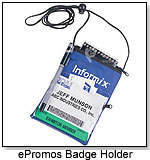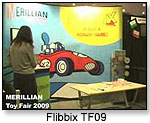 |

Tools:








Event Marketing Guru’s Corner: Harvesting Leads for SalesPart II: Connecting, Collecting and Following Up
| “The activities that tend to make salespeople successful are often causes for failure on the show floor.” |
Part I
In TDmonthly Magazine’s July issue, Part I of this article series covered setting measurable objectives and creating a lead system that will allow event staff to collect the right information in preparation for follow-up with potential clients. Read on for explanation of the most important factors of booth appeal, selection of lead retrieval systems, and key factors in successful follow-up.
UNDERSTAND THE PROCESS
 Show staff should understand that they are the most important aspect of the booth. Nobody buys anything from you until they buy you. Tradeshow attendees who have been surveyed by the Center of Exhibition Industry Research say their most memorable impression of an exhibit is the show staff (CEIR Report MC/RR5040). Show staff should understand that they are the most important aspect of the booth. Nobody buys anything from you until they buy you. Tradeshow attendees who have been surveyed by the Center of Exhibition Industry Research say their most memorable impression of an exhibit is the show staff (CEIR Report MC/RR5040).
Many attendees feel that booth staff don’t take time to determine the true nature of their needs, wasting their time by going on about product features the prospect doesn’t care about. Staff must be trained to understand the entire process — not just “selling.” The activities that tend to make salespeople successful are often causes for failure on the show floor.
Training in advance of the show will make sure staff understand the entire process for obtaining successful leads. Staff should also be well-versed in the art of effective boothmanship to ensure that they effectively connect with prospective attendees. Training should include a review of measurable goals for the show, the most effective way to use the lead system, and the intended process for obtaining and recording the information needed to qualify the lead. This information will help make staff consistent and effective.
CONSIDER SYSTEMS OPTIONS
 Lead retrieval systems have improved, but slowly. Event badge readers provided by lead retrieval companies cannot possibly provide every exhibitor his or her specific qualifying questions and responses. The solution has been to use codes that must be memorized or posted and referred to continually by show staff. Lead retrieval systems have improved, but slowly. Event badge readers provided by lead retrieval companies cannot possibly provide every exhibitor his or her specific qualifying questions and responses. The solution has been to use codes that must be memorized or posted and referred to continually by show staff.
In addition, all of an exhibitor’s events may not use the same vendor, meaning the exhibitor employs a different system from show to show. This results in inconsistent data, making it difficult to accurately measure information. The time it takes to construct meaningful and easy-to-use reports from the data provided (which may not always be accurate or complete) is lengthy. Fortunately, more sophisticated and multi-layered event technology tools have surfaced during the past few years, with the advent of the latest matchmaking technologies.
An alternative is to develop a proprietary system in house. However, getting home-grown systems to read the wide variety allows you to skip irrelevant questions based on a visitor’s knowledge. Example: Instead of prompting the visitor for all competitors’ product names, first ask if the visitor uses any of your competitor’s products; if the answer is “no”, he or she can skip to the next question. If you have a solid follow-up plan, you can limit the number of qualifying questions asked on site by obtaining additional information through a post-show survey.
Don’t collect information show management has already collected. Qualification surveys supplement the demographic surveys administered by show managers (show management’s demographic surveys are completed by visitors upon registration). Answers to those questions are already embedded in each visitor’s lead card and automatically become part of your lead record. Before you design your qualification survey, find out what information show management is capturing by studying the show’s visitor registration form, and omit redundant questions.
FOLLOW UP TO CLOSE LEADS
Before the show, determine how — and how quickly — you’ll follow up on the captured leads. Carefully consider your follow-up from the standpoint of closing sales. It’s the precise spot where the rubber meets the road, and where eight of every 10 exhibitors really drop the ball. Here, you have a host of important decisions to make:
• How will you distribute the captured leads to your sales representatives?
• How will you follow up with those leads: through phone, fax, email, snailmail, or a combination of these?
• What materials will you send to the leads?
• What will your follow-up schedule be?
 Today’s most sophisticated exhibitors typically respond within 24 hours of a lead’s visit to their booth. You should also make an honest assessment as to whether you have the necessary skill sets in-house to access and manipulate your lead data after the show. If you don’t, consider retaining an outside service bureau. You may also want to consider the services of a reliable fulfillment center to ensure rapid follow-up if you anticipate an especially high volume of leads. Today’s most sophisticated exhibitors typically respond within 24 hours of a lead’s visit to their booth. You should also make an honest assessment as to whether you have the necessary skill sets in-house to access and manipulate your lead data after the show. If you don’t, consider retaining an outside service bureau. You may also want to consider the services of a reliable fulfillment center to ensure rapid follow-up if you anticipate an especially high volume of leads.
If an exemplary job of pre-event marketing is done to set up optimal at-event sales consultations (which must follow the rules of effective boothmanship to maximize efficacy), much of your post-event follow up will be focused on congratulating your new clients on “savvy purchasing decisions” and graciously thanking them for “the opportunity to build a relationship” and “be of valuable service” to them.
According to CEIR, “50 percent of exhibition leads do not require a follow-up call in order to close.” In the final analysis (for those leads that do require post-event follow-ups to close amid today’s longer sales cycles), effective follow-up is paramount. This is often where the real job begins.
The keys to successful follow-up are timing (the more expedient, the better!), coordination, personalization and customization of the message (it should always be “fine tailored” to each client’s specific needs). I strongly recommend an integration of personalized email and hand-written snail mail follow-up communications. You’ll find that “short notes yield long results.” Always try to include something “personal” regarding each individual with whom you’re communicating. At its core, this process is one I like to refer as “customer manufacturing.” It’s about “reaching,” “attracting” and “converting” qualified sales leads into new clients.
 Writer's Bio: Writer's Bio: Charles W. Allen is an independent consultant for professional event marketing solutions and specializes in sales training, motivational speaking and maximizing sponsorship sales. He also serves as executive director of the International Economic Alliance, which originated at Harvard University. Read more articles by this author
THIS BANNER IS AN AD:

• • • • • • • • • • • • • • • • • | • • • • • • • • • • • • • • • • • |
Back to TDmonthly's front page
|  |
Advertise on TDmonthly

|

